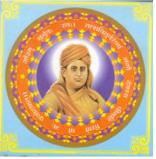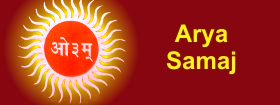Rishi Dayananda Rejuvenates the Vedic Sanskaar Plan
 In an effort to lay bases to spiritually rehabilitate people worldwide, and energize them to reach out to the level of India’s Golden Age again, Rishi Dayananda sought to bring back into popular practice the Karmakaand traditions of Yajña and Sanskaar. Toward this end, Rishi Dayananda wrote a text called the Sanskaar Vidhi which aimed at explaining the performance of Yajñas and Sanskaars. In his Satyaarth Prakaash, he had described the historical, doctrinal and ethical aspects of Vedic Life. This text embodied the sum-total of his message of reform that was meant to lead Hindus to a higher standard of life experience. What was needed now, he felt, was a complement to this text on doctrines, a practical manual that could have provided Hindus concrete directions to guide them onwards in a life aimed at regeneration and to show them how to worship and pray.
In an effort to lay bases to spiritually rehabilitate people worldwide, and energize them to reach out to the level of India’s Golden Age again, Rishi Dayananda sought to bring back into popular practice the Karmakaand traditions of Yajña and Sanskaar. Toward this end, Rishi Dayananda wrote a text called the Sanskaar Vidhi which aimed at explaining the performance of Yajñas and Sanskaars. In his Satyaarth Prakaash, he had described the historical, doctrinal and ethical aspects of Vedic Life. This text embodied the sum-total of his message of reform that was meant to lead Hindus to a higher standard of life experience. What was needed now, he felt, was a complement to this text on doctrines, a practical manual that could have provided Hindus concrete directions to guide them onwards in a life aimed at regeneration and to show them how to worship and pray.
Purpose And Influence Behind The Satyarth Prakash
Conditions of human society prevalent in his time caused Dayananda to react with alarm. Dilating on the causes of India being enslaved for centuries, he bemoans thus:
Having thus diagnosed the cause for India’s virtual collapse, the Rishi set about preparing to administer the antidote. He toured the whole country preaching and teaching with an aim to ending feuds among scholars and narrowing down major differences among religions and their tenets. On a suggestion from his followers that his ideas be recorded for permanence, the Swami set about dictating to his appointed scribes with the express aim of presenting a text that would spell out his principal doctrines in clear terms. This text he chose to call by the name SATYARTH PRAKASH (literally meaning an exposition of the true sense or an exposition of the meaning of Truth). The name is significant in that it brings to light the motivating thoughts uppermost in the Swami’s mind while he was involved in his missionary crusade. In the Introduction to his second Satyarth Prakash, he himself writes:
From this statement, it can be seen that Rishi Dayananda was very much preoccupied with the whole question of Truth, the acceptance of which by scholars “will work greatly to the advantage of the world, for it cannot be denied that differences among the learned create bad blood among the ignorant masses.” It is even recorded in the Swami’s biography that, for greater amity and unity among scholars, he had organized a conference on the occasion of Lord Lytton’s great Durbar at Delhi, in which he had invited leading scholars of the various religious creeds, and had hoped that religious ill-feeling might have ceased among the ordinary masses. And ever so often in the Satyarth Prakash itself, the Swami attempts to put over to the reader that “no one should take offence at my comments; for in offering them, I have been actuated solely by the desire of ascertaining what is true and what is false, and not by malice or desire of injuring susceptibilities.”
While attempting to put forth canons of Truth, as he conceived of them, in the Satyarth Prakash, he does not fail to admit the presence of many learned men in other religions, but these, he complains, “fail to initiate in themselves a spirit of inquiry and true love for wisdom,” without which “it is impossible to arrive at any conclusion as to the correctness of any belief”. The Swami had tremendous faith in the comparative study of religions as a means whereby the people could discriminate between right and wrong. With a view to initiating such a study, he uses his Satyarth Prakash to challenge leaders of other faiths to examine their own creeds, and to lift up their pen in their own defense.
In the nineteenth century, debating was a common means adopted to analyze different topics. The Swami urged the use of such means as they will certainly augment knowledge among men, thereby enabling them to embrace Truth and practice virtue and shun ignorance and vice. The critical approach he adopts in his Satyarth Prakash, the Swami admits, “will be like poison to begin with, but will certainly produce a nectareal effect in the end, because the whole human race, after ascertaining the essence and form of Truth, will be ultimately united under the banner of one universal religion.” He foresees many obstacles in this herculean task, because many people, “through bigotry and prejudice, will deliberately misconstrue the intentions of the author of the text.” The Swami, however, expresses confidence in the better judgment of the masses by “placing this work before all men in the hope that they will embrace Truth and make my labor fruitful”. As a token of his humility, he assures his readers that “all errors and omissions, typographical or otherwise, on being pointed out, will be rectified”, but in the same breath warns those who may contemplate taking undue advantage of this token that “no heed will be paid to anything said or written though prejudice, with the object of unnecessarily criticizing this book.”
More evidence pointing to Rishi Dayananda’s purpose in writing the Satyarth Prakash can be gleaned from the contents and the manner in which the chapters have been named and arranged. The table below is enlightening:
(Content from Arya Samaj Jamnagar)
| Chapter | Principal Focus |
|---|---|
| 1 – God And His Names | It is not without significance that the Rishi focuses on God in the very first chapter. Realizing God is, according to Veda, the very purpose of man’s existence. Human souls need a Name to call upon and connect with God – and this Name must be meaningful. While Om is God’s Primary Name, there are millions of other Names that point to His Qualities and Functions. In understanding the meanings of His Names, we understand how He is and how He works. Understanding His Nature is basic to realizing Him. |
| 2 – The Birth And Upbringing of Children | Human birth is the only birth through which a soul can realize God. Human birth is, therefore, characteristically different from animal birth. Human beings are born in families – animals are not. The institution of Family is God’s gift to human beings. Children need to be conceived, given birth and brought up in a divine way, very different from the way animals are conceived. Because growing up in a desired way in a family is basic to realizing God, the Rishi in Chapter 2 focuses on Sanskaaric methods of starting and bringing up a family. |
| Chapter 3 – The Education of Children | Education is the key to a successful life. Education trains youngsters to have a disciplined body with a disciplined mind. Parents, backed by the community and the State, must make all arrangements to provide a complete education to children, failing which children will be ill-equipped to overcome challenges in daily living. Being ill-equipped is an impediment in the process of realizing the divinity in us. |
| Chapter 4 – Marriage and Family Life | Adults can proceed into married and family life only after having gone through the rigueur of a sound education. Adults disciplined by a sound education will choose their spouses wisely. While discharging their duties, disciplined married partners will be guided by high maxims – like those enunciated in Vedas and Shastras. |
| Chapter 5 – Retirement and Renunciation | Life does not end in married life. Realizing God requires us to step back from personal agenda that so much characterizes family life and start thinking of the social agenda – the common good of all mankind. A life of renunciation is essential to moving away from selfish focus. |
| Chapter 6 – Local And State Government | Personal and family life needs to be regulated by social and administrative laws. A person cannot hope to have spiritual liberation unless he discharges his duties to society and the State. In this Chapter, the Rishi explains the principles of State Administration, and the spiritual value of obeying State Laws. |
| Chapter 7 – God And The Veda | It is not enough to call upon God’s Name in daily meditations. What is God’s vision? How do I develop a personal relationship with Him? How can I enjoy His Bliss? How does Veda answer these and other questions? |
| Chapter 8 – The Universe – Its Creation, Sustenance and Disintegration | Around me is this Universe. The Universe is a Reality – It is not a delusion. I see pattern, order and design, and I can only conclude that an Intelligent Mind designed it. In studying the universe, what sciences can I discover in the heavens? In the sky? In and on Earth? Through what process was the universe evolved? How is it sustained? What happens when it disintegrates? |
| Chapter 9 – Knowledge And Ignorance, Bondage And Liberation | I have lived through life focusing on both the Creator and His Creation. I focus, study and meditate. I have now developed some maturity in my understanding. I feel subtly bound to the world around me. I recognize that ignorance of Reality further tightens the ropes of bondage. I am aware of the concept of Mukti, of Liberation, and I understand that Wisdom is the sole tool that I can employ in breaking free and achieving that Liberation. |
| Chapter 10 – The Philosophy of Conduct And Food | In having Mukti as my goal, I know that my conduct must be in harmony with that goal. I understand that sin will lead me away from that goal. I also understand that food influences my body, my mind and so, my conduct. With Chapter 10, Rishi Dayananda brings the first part of the Satyarth Prakash to a close. |
| Chapter 11 Chapter 12 Chapter 13 Chapter 14 |
I live in a diverse world. Everyone does not think alike. Different communities have different beliefs and practices. Tenets of major Religions – Hinduism, Buddhism, Jainism, Sikhism, Judaism, Christanity, Islam – have an impact on me, whether I am aware or not. Are ALL religions true and correct, even though they propound different concepts? If all are not correct, which ONE is correct? And, how do I know? |
Satyaarth Prakaash can be downloaded in following formats:
